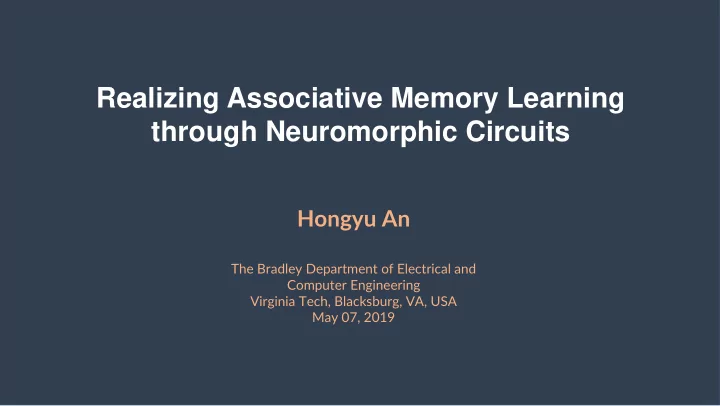

Realizing Associative Memory Learning through Neuromorphic Circuits Hongyu An The Bradley Department of Electrical and Computer Engineering Virginia Tech, Blacksburg, VA, USA May 07, 2019
Research Motivation Associative Memory Humans Invertebrates Mammals Dogs Sea slug Siphon Aplysia Synapse Sensory Neuron Apple Sensory Response Tail Neuron Neuron H. An. 2
Design Methodology The Facts of Associative The Facts of Neural Major Premises Memory system Designs Neurons Synapses Neural Network Circuit Biological Results Response Response Mutual Corroboration H. An. 3
Neurons and Synapses mV mV Axon Soma Dendrites (cell body) Axon Synapse Synapse Brain Neural network Neuron structure Neuron structure model Presynaptic Presynaptic neuron Spiking Signal Synapse functions: terminal 40 mV Transfer signals between neurons • synapse Postsynaptic Neurotransmitter 0 mV Spiking Signal Attenuate the spiking signals • Threshold - 70 mV - 55mV Threshold Postsynaptic neuron Synaptic strength of transmission • terminal - 70mV can be modified E. R. Kandel, Principles of neural science vol. 4: McGraw-hill New York, 2000. H. An. 4
Cellular Level Associative Memory in Sea Slugs Siphon Shelf Sea Slugs Tactile Stimulus Tail Gill Sea Slugs Experimental Setup Unpaired Stimulation Conditional Stimulus (CS) Conditional Stimulus (CS) Paired Stimulation Siphon (CS) Siphon (CS) Siphon Unconditional Unconditional Tail (US) Siphon Stimulus (US) Tail (US) Stimulus (US) Synapse Synapse 5 min 5 min Sensory Neuron Sensory Neuron Cell responses Before training After training Before training After training Siphon sensory Siphon sensory Sensory Response Response neuron neuron Tail Neuron Sensory Neuron Tail Neuron Neuron 2 mV 2 mV Gill motor 50 ms 50 ms Gill motor Gill received signal received signal 5 mV 5 mV Larger Signal Small Signal Before associative memory learning After associative memory learning E. R. Kandel, et al, Principles of neural science vol. 4: McGraw-hill New York, 2000. [2000 Nobel Prize] H. An. 5
Design Methodology The Facts of Associative The Facts of Neural Major Premises Memory system Signal Attenuation • Spiking Signals • The synaptic strength becomes strong during • the associative memory learning Large signal at postsynaptic neuron indicates • a successful learning Designs Neurons Synapses Neural Network Circuit Biological Results Response Response Mutual Corroboration H. An. 6
Signal Intensity Encoding Neuron Current Starved Ring Voltage Controlled Oscillator RC Oscillator 𝐽 𝑒 The switches Spiking signal generation; • Positive and negative outputs; • Magnitude and frequency corresponding to the input. • H. An , et al. , "Monolithic 3D neuromorphic computing system with hybrid CMOS and memristor-based synapses and neurons," Integration, the VLSI Journal, 2017. H. An. 7
Memristor as Synapse Set voltage 1. The synapse should have the capability of attenuating signals; 2. The connecting strength of synapse is adjustable with a set voltage. TEM image: J.-Y. Chen, et al. , "Dynamic evolution of conducting nanofilament in resistive switching memories," Nano letters , 2013. H. An. 8
Design Methodology The Facts of Associative The Facts of Neural Major Premises Memory system Signal Attenuation • Spiking Signals • The synaptic strength becomes strong during • the associative memory learning Large signal at postsynaptic neuron indicates • a successful learning Designs Neurons Synapses Neural Network Memristive Synapse Signal Intensity • • Encoding Neuron Circuit Biological Results Response Response Mutual Corroboration H. An. 9
Reproducing Cellular Associative Memory Learning Neuron B1 (Tail) Positive Spiking Signal Conditional Stimulus (CS) a Siphon Unconditional Negative Stimulus (US) S1 Synapse b Neuron A1 Sensory Neuron Spiking Signals (Siphon) Sensory Response tail Signals superpose together Neuron Neuron Set voltage Paired Stimulation Siphon (CS) Tail (US) 5 min Before training After training Associative memory Siphon sensory behavior occurs neuron Higher current 2 mV Lower current after learning 50 ms Gill motor received signal 5 mV E. R. Kandel, Principles of neural science vol. 4: McGraw-hill New York, 2000. H. An. 10
High Level Associative Memory Learning System Auditory Tone Stimulus Neural Networks Tone signals The brain Response Lateral Nucleus Central Nucleus Shock signals Somatosensory Shock Stimulus Neural Networks • Distinct types of signals are preprocessed at the different regions of brain • The outputs signals after the preprocessing converged at Lateral nucleus E. R. Kandel, Principles of neural science vol. 4: McGraw-hill New York, 2000. H. An. 11
Associative Memory Learning System Auditory Tone Stimulus Neural Networks Tone signals The brain Response Lateral Nucleus Central Nucleus Shock signals Somatosensory Shock Stimulus Neural Networks Unconditional Signal Pathway Visual signal of Artificial Neural Network digit number “3” Response Audio signal of Memristive associative digit number “3” Artificial Neural Network Spiking Signal neural network layer Neurons Transformation Layer Input Outputs Signal Preprocessing Phase Association Phase H. An. 12
Synaptic Weight Updating in Associative Memory Synaptic resistances with no learning (M Ω ) Synaptic resistances after learning (M Ω ) Learning Before Learning After Learning Input signals of SIENs and the response current with the auditory and visual signals of digit number 3 H. An. 13
Conclusion and Significance • Implement a brain-like associative memory learning that relates the pronunciation (auditory signal) and image (visual signal) of digits together by associating two artificial neural networks Explanation Associative memory Brain learning Model Reverse Engineering Engineering Contributions: Scientific Contributions: Human-Like self-learning capability • Potential explanations regarding the • High adaptivity with dynamic surrounding • human learning mechanism environment Potential interpretations of • Novel Human-computer interaction system • memory/forgetting mechanism Spiking Signal based power efficient system • Diseases: Alzheimer’s disease and • visual agnosia H. An. 14
Thank You Hongyu An Virginia Tech hongyu51@vt.edu
Recommend
More recommend